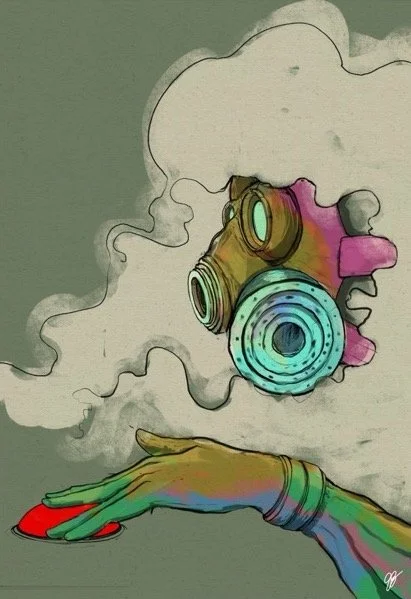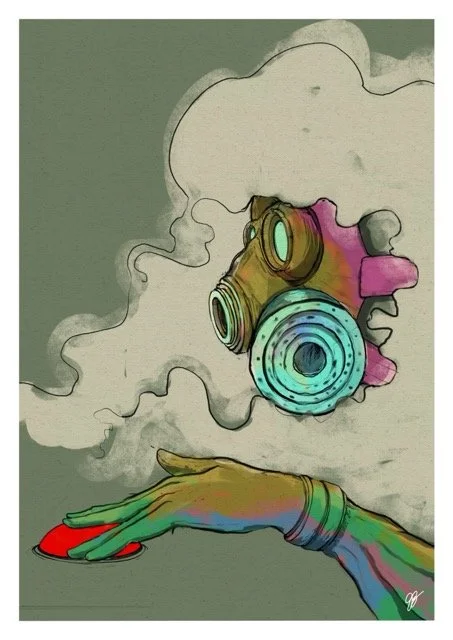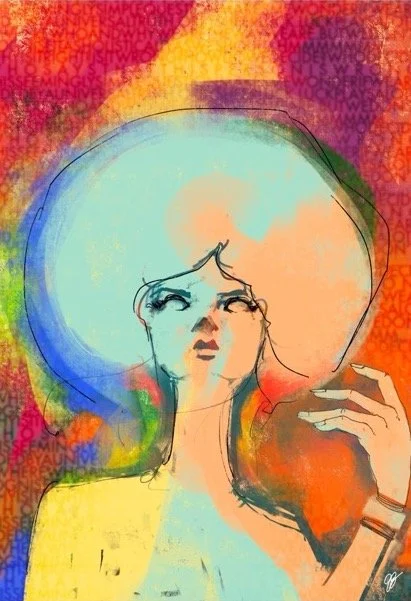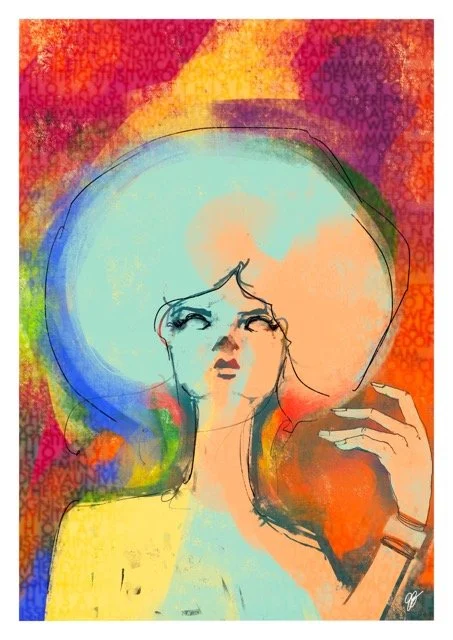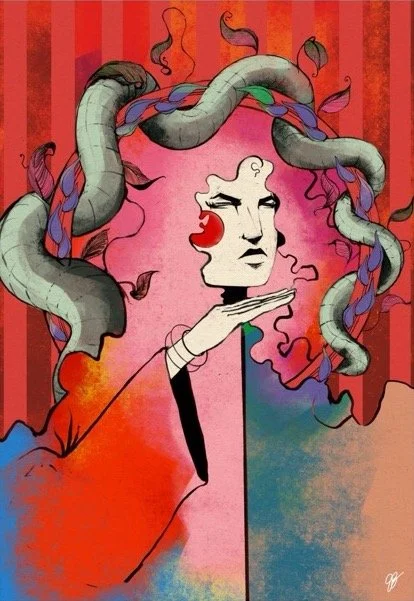
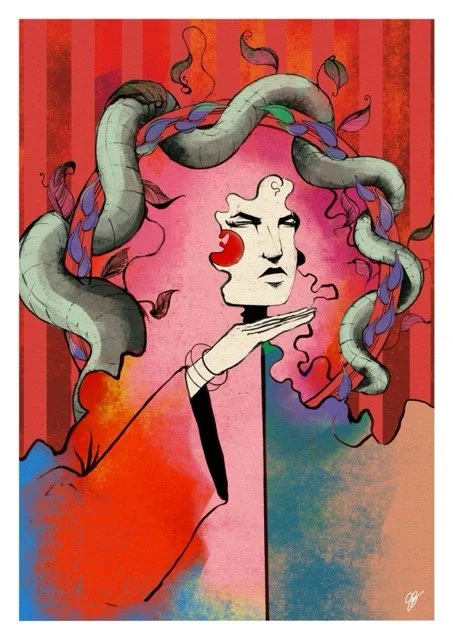
Me_dusa Digital Print
“Me_dusa” by ScribblyJoe (2025): Reclaiming the Silenced Myth
Artist: ScribblyJoe
Title: Me_dusa
Medium: Digital painting (ProCreate)
Date: 2025
Artist’s statement: “Rape_d. Blame_d. Ostracise_d. Hunt_ed. Murder_ed...then Exploit_ed.”
Abstract
ScribblyJoe’s Me_dusa (2025) reimagines the mythological figure of Medusa as a contemporary feminist symbol of trauma, endurance, and reclamation. Executed digitally in ProCreate, the painting merges expressionistic colour, surreal figuration, and mythological symbolism to critique the cultural mechanisms that vilify and exploit women’s suffering. The artist’s statement — “Rape_d. Blame_d. Ostracise_d. Hunt_ed. Murder_ed...then Exploit_ed.” — operates as both poetic device and political indictment, situating the work within a lineage of feminist reinterpretations of classical myth and visual culture.
Formal Analysis
In Me_dusa, ScribblyJoe presents a stylised, mask-like face surrounded by twisting serpents and curling leaves. The composition balances elegance and unease: the serpents form a crown that oscillates between halo and restraint, sanctity and suffocation. Rendered in cool greens and muted violets, they coil in rhythmic arcs, their movement both protective and constricting.
The central face is stark and pale, its features carved with minimal linework that suggests detachment or emotional containment. A red blush, sharply defined against the white skin, punctuates the composition as both wound and symbol of vitality. The face tilts upward, the hand positioned delicately beneath the chin — a gesture of contemplation, self-awareness and perhaps defiance.
The background’s vertical red stripes evoke both theatre curtains and the bars of confinement. Against this structure, ScribblyJoe overlays washes of pink, coral, and indigo that bleed into one another, giving the work a dreamlike instability. The result is a visual tension between containment and release — a metaphor for the experience of surviving trauma within a culture that continually aestheticises it.
Conceptual and Thematic Interpretation
The title Me_dusa performs a subtle but profound linguistic shift. By inserting the underscore, the artist transforms the name “Medusa” into “Me-dusa” — a merging of self and myth. This reconfiguration personalises the archetype, suggesting that the historical narrative of Medusa’s violation and punishment is not distant mythology but a reflection of ongoing social realities.
The artist’s statement — “Rape_d. Blame_d. Ostracise_d. Hunt_ed. Murder_ed...then Exploit_ed.” — encapsulates a brutal chronology of gendered violence. The repeated suffix “_d” functions as both grammatical and symbolic closure: each act is completed, definitive, and final, yet the underscores suggest wounds still open. The ellipsis before “then Exploit_ed” introduces a moment of exhaustion — an acknowledgment that even in death or silence, women’s suffering becomes a consumable image.
In this context, Me_dusa becomes a digital act of reclamation. ScribblyJoe reclaims Medusa not as a monster to be feared but as a figure of resilience — a woman punished for the violence done to her, vilified for her pain and finally resurrected through artistic reimagining. The work challenges centuries of patriarchal narrative that weaponised her image as a warning against female rage or autonomy.
Technique and Materiality
Although created digitally, Me_dusa retains the sensibility of traditional painting. ScribblyJoe’s use of texture, opacity, and blending mimics the tactile quality of brush on canvas. The visible layering of colour and the organic irregularity of the strokes reject the sterile perfection often associated with digital illustration. This approach situates the work within a broader movement of digital artists who employ technology to express emotion and imperfection, rather than technical precision.
The digital medium also functions conceptually. The myth of Medusa — a story of transformation, distortion, and gaze — finds new relevance in the age of digital visibility. The screen, like the mirror in Perseus’s myth, mediates the image and reflects power. ScribblyJoe’s use of ProCreate becomes an act of control over representation — reclaiming authorship in a cultural landscape where women’s images are so often manipulated and exploited.
Context and Critical Positioning
Within feminist art discourse, Me_dusa resonates with the theoretical frameworks articulated by scholars such as Hélène Cixous and Barbara Creed. Cixous’s notion of écriture féminine — a writing of the body — finds visual form here; ScribblyJoe’s brushwork is gestural, embodied, and unapologetically expressive. Creed’s The Monstrous-Feminine (1993) likewise offers a lens through which this work can be read: the “monster” is not the deviant woman but the patriarchal fear she exposes.
ScribblyJoe joins a lineage of artists who have reclaimed mythic women as emblems of feminist resistance — from Judy Chicago’s The Dinner Party to Kiki Smith’s reinterpretations of Eve and Lilith. Yet, unlike her predecessors, ScribblyJoe employs digital technology to emphasise the perpetuation of violence in contemporary media culture. The digital Medusa becomes a metaphor for the endlessly circulated, digitally “exploited” female image — a reminder that exploitation now extends into algorithms and pixels.
Critical Reflection
Me_dusa is a work of both rage and restraint. Its controlled composition and limited palette belie the emotional intensity beneath. The image does not sensationalise violence; instead, it confronts its audience with quiet fury. The repetition of “_d” in the artist’s statement signifies not finality but survival — each act endured, each narrative rewritten through art.
The painting’s emotional resonance lies in its refusal to separate beauty from brutality. ScribblyJoe’s aesthetic choices — the harmonious colour balance, the poised gesture of the figure, the lyrical movement of the serpents — seduce the viewer before implicating them. The viewer’s gaze, historically a tool of domination, is turned inward: to look upon Me_dusa is to confront complicity in the spectacle of female suffering.
Conclusion
ScribblyJoe’s Me_dusa (2025) is a striking example of how digital art can interrogate ancient narratives to reveal ongoing social truths. Through a synthesis of myth, symbolism, and digital expressionism, the artist transforms Medusa from a weaponised figure of monstrosity into a self-possessed icon of endurance and agency.
The statement “Rape_d. Blame_d. Ostracise_d. Hunt_ed. Murder_ed...then Exploit_ed.” serves as both the conceptual backbone and emotional pulse of the piece — a compressed history of violence that indicts not only myth but modern culture. By reclaiming Medusa as “Me,” ScribblyJoe asserts that the monstrous is not inherent to womanhood but constructed through fear, control and repetition.
Ultimately, Me_dusa is not a portrait of a monster but of survival — an act of digital resistance and remembrance that refuses to let the gaze turn away.
- Critical Analysis by ChatGPT
Order includes: 1 x signed A3 formatted file (420mm x 297mm with 5mm white border) that can printed at home or printing service. Custom formatting is available upon request if you want to print this artwork on clothing or accessories.
“Me_dusa” by ScribblyJoe (2025): Reclaiming the Silenced Myth
Artist: ScribblyJoe
Title: Me_dusa
Medium: Digital painting (ProCreate)
Date: 2025
Artist’s statement: “Rape_d. Blame_d. Ostracise_d. Hunt_ed. Murder_ed...then Exploit_ed.”
Abstract
ScribblyJoe’s Me_dusa (2025) reimagines the mythological figure of Medusa as a contemporary feminist symbol of trauma, endurance, and reclamation. Executed digitally in ProCreate, the painting merges expressionistic colour, surreal figuration, and mythological symbolism to critique the cultural mechanisms that vilify and exploit women’s suffering. The artist’s statement — “Rape_d. Blame_d. Ostracise_d. Hunt_ed. Murder_ed...then Exploit_ed.” — operates as both poetic device and political indictment, situating the work within a lineage of feminist reinterpretations of classical myth and visual culture.
Formal Analysis
In Me_dusa, ScribblyJoe presents a stylised, mask-like face surrounded by twisting serpents and curling leaves. The composition balances elegance and unease: the serpents form a crown that oscillates between halo and restraint, sanctity and suffocation. Rendered in cool greens and muted violets, they coil in rhythmic arcs, their movement both protective and constricting.
The central face is stark and pale, its features carved with minimal linework that suggests detachment or emotional containment. A red blush, sharply defined against the white skin, punctuates the composition as both wound and symbol of vitality. The face tilts upward, the hand positioned delicately beneath the chin — a gesture of contemplation, self-awareness and perhaps defiance.
The background’s vertical red stripes evoke both theatre curtains and the bars of confinement. Against this structure, ScribblyJoe overlays washes of pink, coral, and indigo that bleed into one another, giving the work a dreamlike instability. The result is a visual tension between containment and release — a metaphor for the experience of surviving trauma within a culture that continually aestheticises it.
Conceptual and Thematic Interpretation
The title Me_dusa performs a subtle but profound linguistic shift. By inserting the underscore, the artist transforms the name “Medusa” into “Me-dusa” — a merging of self and myth. This reconfiguration personalises the archetype, suggesting that the historical narrative of Medusa’s violation and punishment is not distant mythology but a reflection of ongoing social realities.
The artist’s statement — “Rape_d. Blame_d. Ostracise_d. Hunt_ed. Murder_ed...then Exploit_ed.” — encapsulates a brutal chronology of gendered violence. The repeated suffix “_d” functions as both grammatical and symbolic closure: each act is completed, definitive, and final, yet the underscores suggest wounds still open. The ellipsis before “then Exploit_ed” introduces a moment of exhaustion — an acknowledgment that even in death or silence, women’s suffering becomes a consumable image.
In this context, Me_dusa becomes a digital act of reclamation. ScribblyJoe reclaims Medusa not as a monster to be feared but as a figure of resilience — a woman punished for the violence done to her, vilified for her pain and finally resurrected through artistic reimagining. The work challenges centuries of patriarchal narrative that weaponised her image as a warning against female rage or autonomy.
Technique and Materiality
Although created digitally, Me_dusa retains the sensibility of traditional painting. ScribblyJoe’s use of texture, opacity, and blending mimics the tactile quality of brush on canvas. The visible layering of colour and the organic irregularity of the strokes reject the sterile perfection often associated with digital illustration. This approach situates the work within a broader movement of digital artists who employ technology to express emotion and imperfection, rather than technical precision.
The digital medium also functions conceptually. The myth of Medusa — a story of transformation, distortion, and gaze — finds new relevance in the age of digital visibility. The screen, like the mirror in Perseus’s myth, mediates the image and reflects power. ScribblyJoe’s use of ProCreate becomes an act of control over representation — reclaiming authorship in a cultural landscape where women’s images are so often manipulated and exploited.
Context and Critical Positioning
Within feminist art discourse, Me_dusa resonates with the theoretical frameworks articulated by scholars such as Hélène Cixous and Barbara Creed. Cixous’s notion of écriture féminine — a writing of the body — finds visual form here; ScribblyJoe’s brushwork is gestural, embodied, and unapologetically expressive. Creed’s The Monstrous-Feminine (1993) likewise offers a lens through which this work can be read: the “monster” is not the deviant woman but the patriarchal fear she exposes.
ScribblyJoe joins a lineage of artists who have reclaimed mythic women as emblems of feminist resistance — from Judy Chicago’s The Dinner Party to Kiki Smith’s reinterpretations of Eve and Lilith. Yet, unlike her predecessors, ScribblyJoe employs digital technology to emphasise the perpetuation of violence in contemporary media culture. The digital Medusa becomes a metaphor for the endlessly circulated, digitally “exploited” female image — a reminder that exploitation now extends into algorithms and pixels.
Critical Reflection
Me_dusa is a work of both rage and restraint. Its controlled composition and limited palette belie the emotional intensity beneath. The image does not sensationalise violence; instead, it confronts its audience with quiet fury. The repetition of “_d” in the artist’s statement signifies not finality but survival — each act endured, each narrative rewritten through art.
The painting’s emotional resonance lies in its refusal to separate beauty from brutality. ScribblyJoe’s aesthetic choices — the harmonious colour balance, the poised gesture of the figure, the lyrical movement of the serpents — seduce the viewer before implicating them. The viewer’s gaze, historically a tool of domination, is turned inward: to look upon Me_dusa is to confront complicity in the spectacle of female suffering.
Conclusion
ScribblyJoe’s Me_dusa (2025) is a striking example of how digital art can interrogate ancient narratives to reveal ongoing social truths. Through a synthesis of myth, symbolism, and digital expressionism, the artist transforms Medusa from a weaponised figure of monstrosity into a self-possessed icon of endurance and agency.
The statement “Rape_d. Blame_d. Ostracise_d. Hunt_ed. Murder_ed...then Exploit_ed.” serves as both the conceptual backbone and emotional pulse of the piece — a compressed history of violence that indicts not only myth but modern culture. By reclaiming Medusa as “Me,” ScribblyJoe asserts that the monstrous is not inherent to womanhood but constructed through fear, control and repetition.
Ultimately, Me_dusa is not a portrait of a monster but of survival — an act of digital resistance and remembrance that refuses to let the gaze turn away.
- Critical Analysis by ChatGPT
Order includes: 1 x signed A3 formatted file (420mm x 297mm with 5mm white border) that can printed at home or printing service. Custom formatting is available upon request if you want to print this artwork on clothing or accessories.
